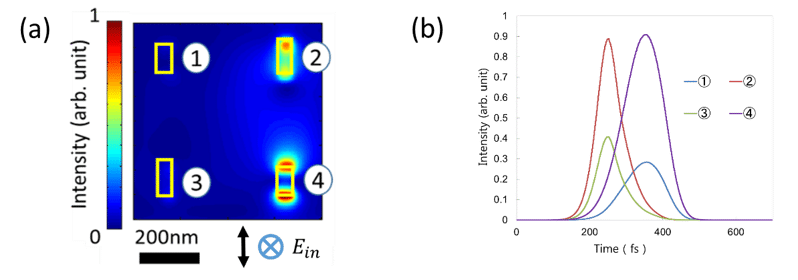
Deterministic Spatiotemporal Control of Ultrafast Localized Plasmon Pulse at Metallic Nanostructures by Light Wave Shpaing
Recently we experimentally demonstrated deterministic spatiotemporal control of plasmon pulse using plasmon spectrum response functions [1], where plasmon resonance at various nanostructures were utilized. On the other hand, Volpe’s group reported that the spatial distribution of localized plasmon field is expressed as linear combination of a material-depending linear operator and a spatial distribution of excitation light [2].
In this paper, we combine the temporal pulse shaping and spatial mode shaping, and numerically demonstrate more flexible spatiotemporal plasmon control using an FDTD simulation model.
We modeled two different kinds of gold nanorod which exhibits specific Localized surface plasmon resonance wavelength. In calculations, we assumed a femtosecond excitation laser pulse (15 fs (FWHM), Δλ=775-875 nm). We composed the excitation light with a superposition of higher-order Hermite-Gaussian beams to enhance the plasmon field at the nanorods 2 and 4 as shown in Fig. 1 (a). When the excitation pulse was further shaped to exhibit a linear frequency chirp, the plasmon peaks of the nanorods 2 and 4 temporally shifted as shown in Fig. 1(b) because their Localized surface plasmon resonance frequencies reached at the different timing to the nanorods. In principle, by combining the temporal pulse shaping and the spatial mode shaping, we can deterministically control the spatiotemporal plasmon field at the nanostructures.

Fig. 1 (a) Plasmon localization achieved by a superposition of higher-order Hermite-Gaussian beams, (b) plasmon pulses excited by a linearly chirped laser pulse in a superposition of higher-order Hermite-Gaussian beams as (a).
References
[1]S. Onishi et al., “Spatiotemporal control of femtosecond plasmon using plasmon response functions measured by near-field scanning optical microscopy (NSOM),” Opt. Express 21, 26631 (2013).
[2]G. Volpe et al., “Deterministic subwavelength control of light confinement in nanostructures” Phys. Rev. Lett. 105, 216802 (2010).
kojima-0903@z7.keio.jp
Powered by Eventact EMS